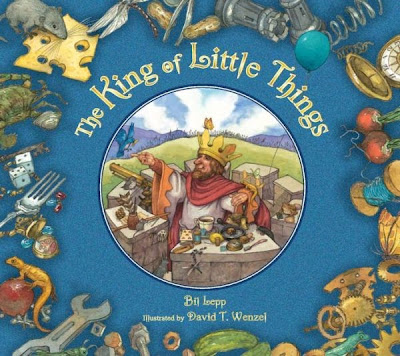
Lepp,
Bil, and David Wenzel. The King of Little
Things. Atlanta: Peachtree, 2013. Print.
ISBN:
978-1-56145-708-3
Audience:
Ages 4-8, Grade PK-3
Summary: In this original fairy tale, King Normous wants to
be the Ruler of All the World and only the King of Little Things stands in the
way of his plans. However, when he attacks the Little Kingdom the king, who
“has all he needs and doesn’t need more,” doesn’t back down. His loyal subjects
back him by fighting back and then continue to support him even after he is
imprisoned. When the little things strike against him, King Normous realizes
that little things do matter after all.
Strengths:
This book introduces unfamiliar
vocabulary in a way that makes it accessible and fun. Lepp is also a master of figurative
language, who manages to weave in alliteration, metaphors, similes, and rhythm
without ever losing the narrative storyline. Wenzel’s illustrations include
amazing detail and highlight the humor in Lepp’s tale. This book is a joy to
read!
Weaknesses:
I feel the recommended ages for this book should be expanded. While it would be
appropriate for younger grades as a read aloud or a genre example, it could
easily be used in the upper elementary grades for an exemplar text. The
language is masterful and much of the vocabulary is grade-level appropriate for
older students.
Uses:
This book would work well for a genre
story on fairy tales and fables (CCSS ELA:RL.2 Grades 2- 4) or a discussion of
themes (CCSS ELA: RL.2 Grades K-6). The expressive language and vocabulary
would make it a perfect mentor text for writing (CCSS ELA:L.4 Grades 3-5 and CCSS
ELA:W.3 Grades K-6) as well as one to take apart for an in-depth study of
figurative language (CCSS ELA:L.5 Grades 1-6).
Read-alikes:
- The Three Pigs - David Wiesner (Wiesner’s unique take on the traditional tale)
- The Lion & the Mouse- Jerry Pinkney (A familiar story with a similar theme)
- The Once Upon a Time Map Book- B.G. Hennessey (Detailed maps of fairy tale lands.)
- The Teacher in the Patriotic Bathing Suit – Bil Lepp (Audio recording of the author telling stories.)
Awards:
Parent’s
Choice Gold
Bank
Street Best Books finalist
Other: Starred review in Kirkus
